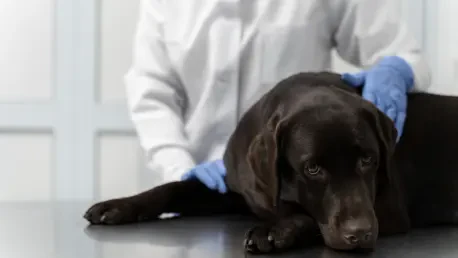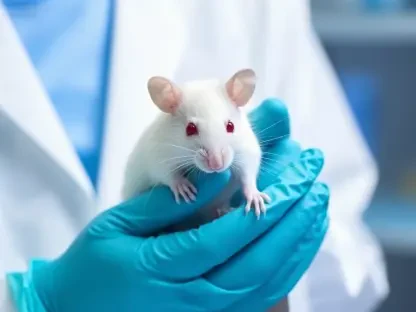In the intricate web of veterinary health challenges in Southern China, a pressing concern has emerged with the evolution of feline parvovirus (FPV) and canine parvovirus (CPV), pathogens that severely impact cats and dogs. These viruses, belonging to the Parvoviridae family, are notorious for causing acute diseases characterized by vomiting, hemorrhagic enteritis, and severe immune suppression. The significance of understanding their genetic evolution cannot be overstated, as mutations and cross-species transmission pose substantial risks to pet populations. A recent study conducted between 2023 and 2024 in Guangdong Province has shed light on how these viruses adapt and spread, revealing high infection rates and novel mutations that could alter their behavior. This exploration not only highlights the dynamic nature of viral evolution but also underscores the urgent need for updated control measures to mitigate outbreaks in the region.
The focus of this research is to delve into the molecular changes and co-circulation patterns of FPV and CPV, particularly how CPV adapts to feline hosts, thereby increasing epidemiological risks. By examining hundreds of samples from affected animals, the study provides critical insights into prevalence rates, genetic diversity, and the potential for genetic recombination. These findings are pivotal for veterinarians and researchers aiming to develop effective strategies to curb the spread of these viruses. As the interplay between cats and dogs facilitates viral exchange, understanding these mechanisms is essential for safeguarding animal health across Southern China.
1. Understanding the Viral Threat and Study Purpose
Parvoviruses like FPV and CPV represent a significant threat to domestic animals due to their highly contagious nature and ability to cause severe gastrointestinal distress, making them a critical concern for pet owners and veterinarians alike. FPV primarily affects cats, leading to feline panleukopenia, a condition marked by drastic white blood cell depletion and reproductive issues. CPV, originally derived from FPV through mutations, targets dogs with similar symptoms but has shown an alarming capacity to infect cats as well, creating a complex cycle of transmission. The VP2 protein, a major component of the viral capsid, plays a crucial role in host recognition and immune response, making it a focal point for studying viral adaptability. Mutations in this protein can alter how the virus interacts with host cells, potentially evading vaccines and complicating prevention efforts. This study, conducted in Southern China, aimed to analyze these evolutionary changes by focusing on the genetic makeup of viral strains collected from symptomatic animals.
The primary objective was to investigate the molecular evolution of FPV and CPV in a region with frequent pet interactions, assessing how these viruses co-circulate among cats and dogs. Between 2023 and 2024, the research targeted animals displaying high fever and diarrhea, conditions often linked to parvovirus infections. By exploring prevalence rates and identifying novel mutations, the study sought to uncover the risks of cross-species transmission, particularly CPV’s adaptation to feline hosts. These insights are vital for informing outbreak control strategies, ensuring that veterinary practices can adapt to emerging viral threats. The findings also aim to provide a foundation for future research into vaccine efficacy and the broader implications of viral evolution in densely populated pet communities.
2. Methodology for Sample Collection and Viral Detection
To comprehensively study the evolution of FPV and CPV, a robust methodology was employed to gather and analyze samples from affected animals in Guangdong, China, ensuring a thorough understanding of the viruses’ development over time. Between 2023 and 2024, a total of 657 rectal swabs were collected from veterinary hospitals, with 356 samples from cats and 301 from dogs. The selection focused on animals exhibiting clinical signs such as high fever and diarrhea, indicative of parvovirus infection. Each sample was carefully stored in a 2-mL centrifuge tube with phosphate-buffered saline (PBS), subjected to repeated squeezing to extract viral material, and then centrifuged at 13,400 g for 10 minutes. The resulting supernatant was filtered through a 0.22-µm membrane to remove contaminants and preserved at -80°C to maintain viral integrity for subsequent testing. This meticulous process ensured that the samples remained viable for accurate detection and analysis.
Following collection, viral nucleic acids were extracted using a specialized kit designed for DNA and RNA isolation. Polymerase chain reaction (PCR) was conducted with specific FPV and CPV primers under controlled conditions, including an initial denaturation at 94°C for 5 minutes, followed by 40 cycles of denaturation, annealing at 60°C, and extension at 72°C. To ensure purity, additional tests screened for other common viruses such as feline calicivirus (FCV), feline herpesvirus (FHV), feline coronavirus (FCOV), and canine distemper virus (CDV). Positive and negative controls were included in every experiment to validate results, and PCR products were analyzed via 1% agarose gel electrophoresis. Statistical analysis using specialized software further confirmed the findings, providing a reliable dataset on infection prevalence and viral presence in the sampled population.
3. Techniques for Virus Isolation and Cultivation
Once samples tested positive for FPV or CPV and were confirmed free of other viral contaminants, they were subjected to isolation and cultivation to study viral behavior in a controlled environment. Samples were inoculated at a 1:10 ratio onto Crandell-Rees Feline Kidney (CRFK) cell monolayers and incubated at 37°C with 5% CO2 for one hour, with periodic shaking every 20 minutes to ensure uniform viral adsorption. Post-incubation, the cells were washed three times with PBS at pH 7.4 to remove unbound material. Dulbecco’s Modified Eagle’s Medium, supplemented with 1% fetal bovine serum and a 1:100 ratio of penicillin-streptomycin antibiotics, was added, and the cells were incubated under the same conditions until cytopathic effects (CPEs), such as cell crumpling and detachment, were observed, indicating viral replication.
The cultures were closely monitored for up to 96 hours per passage, with a maximum of five passages performed to amplify the virus. When the cytopathic effect (CPE) reached 80-90% of the culture, the Petri dishes were frozen at -80°C, thawed three times to lyse cells, and centrifuged at 4°C and 13,400 g for 10 minutes. The supernatant, collected as viral stock, was tested again via PCR with specific primers to confirm the presence of FPV or CPV. Viral purification was achieved through a plaque method, and identification was verified using an immunofluorescence assay (IFA) with specific antibodies and electron microscopy to observe viral morphology. These rigorous steps ensured the isolation of high-purity viral strains for further genetic and structural analysis, providing a clear picture of viral characteristics in the host cells.
4. Sequencing and Analysis of the VP2 Gene
A critical component of understanding parvovirus evolution involved sequencing the VP2 gene, which is central to viral structure and host interaction. Positive samples from viral isolation were amplified using PCR with primers targeting the full-length VP2 gene, employing a high-fidelity DNA polymerase kit to ensure accuracy. The resulting PCR products were analyzed on a 1% agarose gel via electrophoresis, purified to remove contaminants, and cloned into the pMD19-T Vector. This ligation mixture, containing the vector, PCR product, and necessary reagents, was incubated at 16°C for 30 minutes. Subsequently, the ligation product was transformed into JM109 competent cells, which underwent a heat shock at 42°C for 45 seconds to facilitate uptake, followed by cooling and recovery in Luria-Bertani (LB) liquid medium without antibiotics.
After transformation, the cells were cultured on selective agar plates containing specific markers to identify successful clones. White colonies, indicative of successful insertion, were selected, and the length of the inserted fragment was verified through PCR. Positive clones were sent to a third-party sequencing service for detailed genetic analysis. The resulting sequences were compared for homology using software tools like DNASTAR, and phylogenetic trees were constructed with MEGA to map evolutionary relationships. This process identified key mutations and genetic variations in the VP2 gene across different FPV and CPV strains, offering insights into how these changes might influence viral behavior and host specificity in Southern China’s pet population.
5. Genetic and Structural Insights into Viral Evolution
Beyond sequencing, a deeper analysis of genetic and structural changes in FPV and CPV was conducted to understand their evolutionary trajectories. The VP2 sequences were examined for nucleotide and amino acid homology using advanced software, comparing them against reference strains from global databases like the National Center for Biotechnology Information (NCBI). Phylogenetic trees, built using the neighbor-joining method with 1000 bootstrap replicates, revealed clustering patterns that highlighted genetic similarities and divergences among isolated strains. Additionally, recombination analysis using RDP4 software identified potential genetic exchange events between FPV and CPV, suggesting that these viruses might not only mutate independently but also swap genetic material, enhancing their adaptability.
Structural predictions of the VP2 protein focused on hydrophobicity, antigenic index, and surface probability, utilizing tools like DNASTAR to compare isolated strains with vaccine reference strains. Tertiary structure modeling with PyMOL further illustrated how specific mutations could alter the spatial conformation of the VP2 protein, potentially impacting host cell receptor binding and immune evasion. These structural insights are crucial for understanding how minor genetic changes can lead to significant functional shifts, such as increased adaptability to new hosts. The combination of genetic and structural analyses provided a comprehensive view of how these parvoviruses evolve, emphasizing the dynamic nature of their interaction with host environments in Southern China.
6. Assessing Viral Adaptation Through Serial Passage
To explore how CPV adapts to feline hosts, serial passage experiments were conducted using the feline-derived CPV-2c-GD08-23 strain in CRFK cells, with the goal of understanding its adaptation mechanisms and replication behavior over multiple passages. The strain was inoculated at a 1:10 ratio onto 80-90% confluent cells in 6-well plates, incubated at 37°C with 5% CO2 for one hour, and shaken every 20 minutes to ensure even adsorption. After washing with PBS, a medium with 1% fetal bovine serum and antibiotics was added, and cells were cultured with daily monitoring for CPE over 96 hours per passage, up to 18 passages. Cultures showing full CPE underwent three freeze-thaw cycles, were centrifuged at 13,400 g at 4°C for 10 minutes, and the supernatant was passaged onto new cells. Viral titers were measured using TCID₅₀ assays across serial dilutions in 96-well plates, calculated via the Reed-Muench method to assess replication efficiency.
Throughout the passages, VP2 gene sequencing was performed to detect mutations, with particular attention to changes in viral behavior. Viruses from key passages (P1, P8, P15, P16, P18) were inoculated into CRFK cells, and IFA was used to measure VP2 protein expression via fluorescence intensity, analyzed with ImageJ software. Statistical comparisons using independent t-tests determined significant differences in fluorescence and titer levels, with a p-value less than 0.05 indicating notable changes. These experiments revealed a reversion mutation (Gly568Ala) by the 16th passage, correlating with a significant drop in viral titer and fluorescence intensity, suggesting potential adaptive attenuation in feline cells. Such findings highlight the complex mechanisms through which CPV adjusts to non-native hosts.
7. Key Results on Prevalence and Genetic Diversity
The study yielded significant findings on the prevalence of parvoviruses in Southern China, with FPV detected in 60.4% of the 356 cat samples and CPV in 50.8% of the 301 dog samples tested between 2023 and 2024, highlighting the widespread nature of these viruses. These high positivity rates underscore the pervasive nature of these viruses among symptomatic animals in Guangdong Province. Viral isolation efforts resulted in the successful cultivation of 14 FPV strains from cats, alongside 2 feline-derived CPV-2c strains, and 17 canine-derived CPV strains, which included 11 CPV-2c, 4 CPV-2a, and 2 CPV-2b subtypes. This distribution indicates a dominant presence of the CPV-2c subtype in the region, reflecting a shift in viral dynamics that could influence disease management strategies.
Further analysis of the VP2 gene revealed novel amino acid mutations that distinguish these isolates from reference strains, indicating significant genetic diversity. In FPV strains, mutations such as Gly31Ala, Ala300Gly, and Ala568Gly were identified, while feline-derived CPV-2c strains showed changes like Ala5Gly and Pro495His. Canine-derived CPV strains exhibited mutations including Glu318Pro and Asp505Lys. These genetic variations suggest ongoing evolutionary pressure that may enhance viral adaptability or alter antigenicity. Additionally, four potential recombination events were detected, pointing to genetic exchange between FPV and CPV strains, which could further complicate the epidemiological landscape by creating hybrid viruses with unpredictable traits.
8. Implications of Mutations and Cross-Species Transmission
The mutations identified in the VP2 gene of FPV and CPV isolates carry significant implications for viral behavior and host interaction, and structural modeling indicates that changes like Ala300Gly in FPV and Pro495His in feline-derived CPV-2c alter the protein’s conformation. These alterations potentially affect how the virus binds to host receptors or evades immune responses. Some mutations appear to influence antigenicity more than virulence, suggesting a risk of reduced vaccine efficacy rather than increased disease severity. For instance, the Ala300Gly mutation introduces greater flexibility in the VP2 structure, which could impact antibody recognition, highlighting the need for updated vaccine formulations to match circulating strains in Southern China.
Cross-species transmission remains a critical concern, as evidenced by the detection of feline-derived CPV-2c strains. Phylogenetic analysis shows a close genetic relationship between feline and canine CPV-2c isolates, with over 99% homology, indicating that dogs likely serve as a reservoir for spillover infections into cats. This transmission cycle is facilitated by frequent contact between the two species, increasing the risk of cats becoming secondary hosts for CPV. Such dynamics suggest that cats are not merely transient hosts but potential reservoirs, amplifying the virus’s persistence in the environment. These findings emphasize the importance of monitoring both species to prevent outbreaks and mitigate the spread of adapted viral strains.
9. Epidemiological Risks and Vaccine Challenges
The adaptation of CPV to feline hosts presents substantial epidemiological risks, particularly in regions like Southern China where pet populations are dense and interactions are frequent. The confirmation of stable viral replication in cats through high-load feline-derived CPV-2c isolates challenges the notion that cats are only incidental hosts. This adaptation increases the likelihood of sustained viral circulation between cats and dogs, potentially leading to more frequent outbreaks if not addressed. The study’s findings suggest that without intervention, CPV could establish a more permanent presence in feline populations, complicating control efforts and heightening the disease burden across species.
Vaccine efficacy is a pressing issue, as antigenic differences between isolated strains and commercial vaccine strains may limit cross-protection, posing significant challenges to animal health. Current vaccines, often based on older FPV strains, might not fully neutralize emerging CPV variants like CPV-2c in cats, due to mutations at key antigenic sites. While some cross-reactivity exists between FPV and CPV, the reduced effectiveness against new variants calls for regular updates to vaccine compositions to align with circulating genotypes. Long-term epidemiological surveillance, combined with neutralization testing, is necessary to evaluate vaccine performance dynamically and ensure that vaccination strategies remain effective against evolving viral threats in the region.
10. Study Limitations and Areas for Improvement
Despite the comprehensive nature of the research, certain limitations must be acknowledged in interpreting the results, especially since the sample size, although substantial at 657, was derived solely from hospital-referred animals displaying clinical symptoms. This approach potentially skews the data toward more severe cases and overlooks healthy or stray populations. This selection bias might not fully represent the broader prevalence and dynamics of FPV and CPV in Southern China. Future studies should incorporate stratified sampling to include diverse groups such as household pets, stray animals, and those without clinical signs, providing a more complete epidemiological picture.
Additionally, the geographic scope was restricted to Guangdong Province, limiting the generalizability of findings to other areas within Southern China or beyond. Ecological and regional differences could influence viral evolution and transmission patterns, necessitating broader sampling across varied landscapes. Another constraint lies in the lack of experimental validation for structural predictions of VP2 mutations, as reverse genetics or neutralization assays were not conducted to confirm functional impacts. Addressing these gaps through expanded sampling and targeted experimental approaches will enhance the understanding of parvovirus dynamics and support more robust conclusions.
11. Reflecting on Findings and Future Directions
Looking back, the study conducted between 2023 and 2024 marked a significant step in unraveling the genetic diversity and evolutionary patterns of FPV and CPV in Southern China’s domestic cat population. It pinpointed novel mutations and recombination events that facilitated CPV’s adaptation to feline hosts, thereby heightening the risk of widespread transmission. The identification of feline-derived CPV-2c strains provided concrete evidence of cross-species transmission, offering crucial data that informed initial outbreak control measures. These insights laid a foundational understanding of how these viruses adapted and co-circulated within a specific regional context.
Moving forward, actionable steps include expanding research with larger, more diverse sample sizes to capture a wider spectrum of animal populations, including strays and asymptomatic individuals. In vitro neutralization and infection experiments using primary cells from both canines and felines are planned to validate the effects of identified mutations on host adaptation. Extending surveillance across different ecological and geographical zones will also be critical to monitor ongoing viral evolution and transmission dynamics. These efforts aim to translate current findings into practical intervention strategies, ensuring that prevention and control measures keep pace with the evolving nature of parvoviruses in Southern China.









